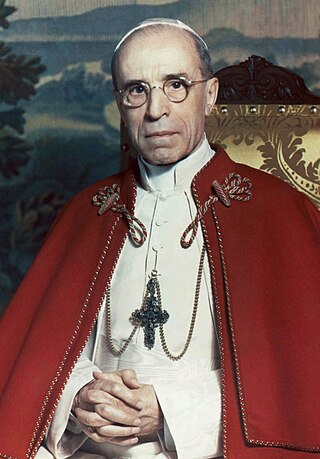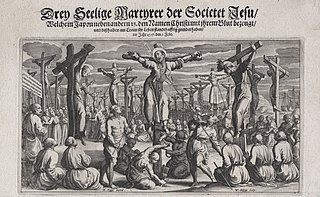Related Research Articles

Pope John XXIII was head of the Catholic Church and sovereign of the Vatican City State from 28 October 1958 until his death in June 1963.

Pope Pius XII was head of the Catholic Church and sovereign of the Vatican City State from 2 March 1939 until his death in October 1958. Before his election to the papacy, he served as secretary of the Department of Extraordinary Ecclesiastical Affairs, papal nuncio to Germany, and Cardinal Secretary of State, in which capacity he worked to conclude treaties with various European and Latin American nations, including the Reichskonkordat treaty with the German Reich.

Pope John Paul I was head of the Catholic Church and sovereign of the Vatican City from 26 August 1978 until his death 33 days later. His reign is among the shortest in papal history, resulting in the most recent year of three popes and the first to occur since 1605. John Paul I remains the most recent Italian-born pope, the last in a succession of such popes that started with Clement VII in 1523.

Pope Paul VI was head of the Catholic Church and sovereign of the Vatican City State from 21 June 1963 to his death on 6 August 1978. Succeeding John XXIII, he continued the Second Vatican Council, which he closed in 1965, implementing its numerous reforms. He fostered improved ecumenical relations with Eastern Orthodox and Protestant churches, which resulted in many historic meetings and agreements. In January 1964, he flew to Jordan, the first time a reigning pontiff had left Italy in more than a century.

Pope Leo XII, born Annibale Francesco Clemente Melchiorre Girolamo Nicola della Genga; 2 August 1760 – 10 February 1829), was head of the Catholic Church and ruler of the Papal States from 28 September 1823 to his death in February 1829.
Paola Elisabetta Cerioli, born Costanza Cerioli Buzecchi-Tasis, was an Italian Roman Catholic widow and the founder of both the Institute of Sisters of the Holy Family and the congregation of the Family of Bergamo.

The Martyrs of Japan were Christian missionaries and followers who were persecuted and executed, mostly during the Tokugawa shogunate period in the 17th century. The Japanese saw the rituals of the Christians causing people to pray, close their eyes with the sign of the cross and lock their hands together – this was seen as psychological warfare against the Japanese and this was punished as such. More than 400 martyrs of Japan have been recognized with beatification by the Catholic Church, and 42 have been canonized as saints.

The theology of Pope Pius XII is reflected in his forty-one encyclicals, as well as speeches and nearly 1000 messages, during his almost 20-year pontificate. The encyclicals Mystici corporis and Mediator Dei advanced the understanding of membership and participation in the Catholic Church. The encyclical Divino afflante Spiritu began opening the door to historical-critical biblical studies. But his magisterium was far larger and is difficult to summarize. In numerous speeches Catholic teaching is related to various aspects of life, education, medicine, politics, war and peace, the life of saints, Mary, the mother of God, things eternal and temporal.
The canonization process of Pope Pius XII dates to shortly after his death in 1958. He was declared a servant of God in 1990 and venerable in 2009. Father Peter Gumpel was the relator of Pius XII's cause for canonization. The potential beatification of Pius XII has raised concern, especially by Jewish organisations, because of his controversial record during the Holocaust. The objections especially arise because of the refusal by the Vatican to allow independent access to the Vatican's archives for the period of Pius XII's papacy.

Maria Repetto was an Italian Roman Catholic professed religious from the Sisters of Our Lady of Refuge in Mount Calvary. Repetto was an ardent devotee of Saint Joseph and promoted devotion to him while distributing medals and images of him to those who visited the convent she was at; she also distinguished herself as an able carer for cholera victims on two occasions of epidemic.

Giovanni Calabria was an Italian Roman Catholic priest who dedicated his life to the plight of the poor and the ill. He established two congregations, the Poor Servants of Divine Providence and the Poor Sisters Servants of Divine Providence to take better care of poor people in various Italian cities and later abroad while underpinning the need to promote the message of the gospel to the poor.
References
- ↑ Jan Olav Smit, Pope Pius XII, London and Dublin 1951, pp 280–281
